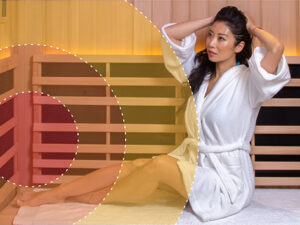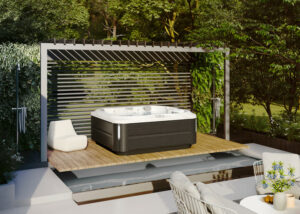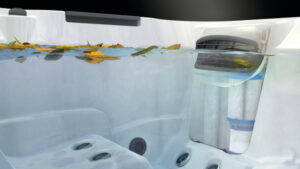When people first begin searching for their perfect hot tub, where they’re going to install it is one of the first things they ask themselves. This usually leads to the question,
“Can I install my hot tub indoors?”
In short, YES!
Indoor hot tubs are an alluring prospect for many, and with the right planning, they can be an exciting new addition to your home!
Have you been considering investing in a hot tub but dread the idea of battling the snow on your cover before a relaxing session? Or maybe you live in a busy neighborhood and get anxious at the thought of prying eyes during what’s supposed to be a relaxing moment of your day.
If this sounds like you, then an indoor hot tub installation is the way to go!
As with anything, there are some important things to consider before deciding on an indoor installation. We’ll cover the ten most important things to consider when deciding on an indoor hot tub install, but first, let’s explore the benefits and challenges of an indoor hot tub!
Benefits of Indoor Hot Tubs
Having an indoor hot tub can provide both you and your spa with several benefits, making your relaxing soak more enjoyable than you may have imagined! Here are some of the best benefits indoor hot tubs offer.
- Maximum privacy
- Easy accessibility
- More energy efficient
- Reduced wear and tear
- Easier maintenance routine
- Makes use of unused space
Not everyone has a wide-open property with far away neighbors, and for many, this means multistory homes right next door, making it easy for people to peer into their backyard!
Having your hot tub indoors takes that worry away, making each soak completely private and stress-free.
Indoor hot tubs also make it easy to use your hot tub 365 days of the year. There will be no need to freeze as you brush snow off your cover or have your relaxation plans foiled by a sudden snowstorm. Having your hot tub indoors ensures you can enjoy your spa anytime you want with ease.
Additionally, when your hot tub is installed indoors, it’s better able to stay at one temperature without having to battle the cold weather during the winter. This helps reduce its energy use, saving you money on your energy bills each month.
This also helps protect your spa from the elements, keeping your water clean and free of the contaminants it would experience outside, like insects, dust, and leaves. Not only that but your cover and cabinet won’t be exposed to the outdoors either, extending their lifetime and making caring for them easy.
The Challenges of Indoor Hot Tubs
Unfortunately, indoor hot tubs can add some additional challenges that you may not experience with an outdoor hot tub installation.
- More expensive
- More difficult to install
- Stronger odors
Installing your hot tub indoors is often more expensive because it takes more work for the technicians to get it into the room and setup. Not only that, but it can also leave you with higher insurance rates.
You may also experience your room strongly smelling like chlorine. The good news is this can be easily combated with good ventilation and proper water balance. However, your water should never have a strong odor to it, and if it does, it’s likely a sign that your chemicals are out of balance.
10 Things to Consider for Indoor Hot Tub Installations
Now that you know the pros and cons of indoor hot tubs let’s explore ten things you need to consider before officially choosing an indoor installation.
1. Know How You’ll Get It Into The Room
First and foremost, the main deciding factor in whether an indoor hot tub is possible is whether or not you can get it into the room.
Some people build separate rooms entirely for their hot tubs, making it easy to create an indoor installation, while others choose to have their hot tub brought into an already existing room that’s gone unused.
If you plan on having your hot tub brought into a current room in your house, you’ll need to make sure your hot tub can fit through your doorway.
Maybe you have french doors that allow you to move your hot tub into the room or a large sliding patio door that will give you the amount of access you need.
Whatever it is, you need to have a plan for getting the hot tub indoors if you’ve chosen this installation.
If it’s simply not possible with the existing room you have, you’ll need to decide if you’re going to switch to an outdoor installation or if it’s in the budget to build a new extension to make your indoor hot tub dreams a reality.
2. Choosing the Right Hot Tub
While any hot tub can be installed indoors, some models are more suitable than others. To choose the right one for you, you’ll want to consider the spa’s size, shape, and weight, in comparison to your room.
It’s also important to know the power requirements for your chosen model. Some require a higher voltage than others, so ensure your room has the capability of supporting those needs.
3. Deciding Where to Place it
Where you install your hot tub will have a big impact on the look of your room.
One of the most popular placement options is in one corner of the room. This helps maintain the open space, ensuring it doesn’t feel overcrowded.
For a more grand appearance, consider installing it in the middle of the room, making your spa an eye-catching centerpiece.
4. Ventilation Needs
Hot tubs produce a significant amount of moisture, and when they’re in a closed-off room, that moisture can linger in the air, causing mold or a buildup of chemical gasses if proper ventilation is not used.
Before installing your hot tub indoors, ensure you’ve added ventilation options to remove the moisture from the air and allow the gas produced by your chemicals to be drawn out of the room.
If you have windows, simply opening them can help, but one of the best ways to combat the build-up of humidity is to use an extraction fan, much like the ones in bathrooms. This will make managing the moisture in your spa room as easy as flipping a switch!
5. Your Walls
As mentioned above, hot tubs release a lot of moisture into the air, which can cause damage to your walls. Regular drywall isn’t made to withstand that kind of damp moisture for extended periods, so it’s not the best option for housing a hot tub.
While your ventilation will help, the walls of your room will still be exposed to higher levels of humidity and moisture long term, and it’s important to ensure your walls can handle that kind of environment.
When considering the room you want to use for your in-home spa, you’ll want to ensure that the vapor barrier under your wall coverings is intact. This will protect the frame of your walls from developing dry rot.
Ultimately, the best walls to use for an indoor spa are cement, glass, or water-resistant drywall, like the ones in your bathrooms or kitchens.
6. The Height of Your Ceilings
This is often an overlooked aspect when first considering an indoor hot tub.
Hot tubs need space above them for their cover to be lifted, and if your ceilings are too low, you may be unable to open your hot tub properly. The last thing you want is to be fighting with your hot tub cover every time you want to enjoy a quiet soak!
To avoid this, you’ll want to compare the height of your hot tub to the overall height of your ceiling to ensure your cover will have enough room to be removed, and you’ll be able to easily get in and out of your spa.
7. Your Water Source
Hot tubs need a reliable and easily accessible water source. With quarterly water changes, you won’t want to be fighting to refill your spa each time.
Consider how you’ll refill your hot tub once it’s in your space.
If you have windows, maybe you can easily bring the garden hose in and refill it from your outdoor water valve. You might also have an indoor faucet that would allow for a hose to be connected to it.
Having an easily accessible water source will make maintaining your water levels and refilling your spa easy.
8. Your Flooring
Whether it’s the water that gets on the floor as you step out of the spa or your kids splashing during an exciting hot tub party, water ending up on your flooring is inevitable.
Protecting your floors from damage is essential and can be as easy as using water-resistant flooring and a floor drainage system.
You’ll also want to ensure the flooring you choose is either textured or anti-slip, so you can step out of your spa with confidence, knowing you’ve taken steps to make your room as safe as possible!
9. Drainage
Drainage is essential in your indoor hot tub installation. Before you install your spa, plan how you’ll drain your hot tub when it comes time for its quarterly clean and how you’ll remove any water that splashes on the floor during use.
One of the most popular options is installing a sump pump below your spa and a floor drain on the surface of your floor. This can make draining your hot tub easy and keeps your floor from developing puddles.
10. Its Foundation
The foundation for your hot tub is one of the most important parts of your installation.
Your foundation will need to be strong enough to support your hot tub’s total weight after it’s been filled and perfectly level to maintain an equal amount of weight across the entire base of your spa.
If the weight is heavier on one side, you can cause irreversible damage to your spa long-term, so it’s essential you take the proper precautions when preparing for your spa installation.
For added safety, you may consider adding a special platform in your room specifically for your hot tub to sit on, giving you peace of mind that your floor can properly support your spa.
Indoor Hot Tubs for Sale in Chelan
Are you ready to boost the value of your home with a private oasis? Swim World has everything you need, from expertly crafted hot tubs to outdoor living essentials.
We’ve been in the relaxation business for over 40 years, and our number one priority has always been providing our customers with top-quality spas with the most innovative technology available.
If you’re ready to discover your new hot tub, visit our impressive showroom or contact us, and one of our team members will happily answer any questions you may have.





 by
by 